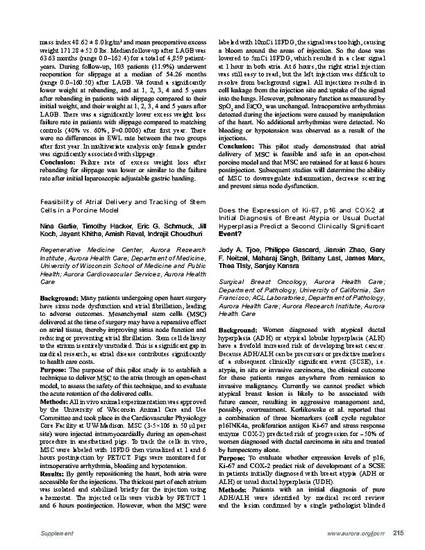
- breast cancer,
- atypia,
- invasive carcinoma,
- biomarker expression
Background: Women diagnosed with atypical ductal hyperplasia (ADH) or atypical lobular hyperplasia (ALH) have a fivefold increased risk of developing breast cancer. Because ADH/ALH can be precursors or predictive markers of a subsequent clinically significant event (SCSE), i.e. atypia, in situ or invasive carcinoma, the clinical outcome for these patients ranges anywhere from remission to invasive malignancy. Currently we cannot predict which atypical breast lesion is likely to be associated with future cancer, resulting in aggressive management and, possibly, overtreatment. Kerlikowske et al. reported that a combination of three biomarkers (cell cycle regulator p16INK4a, proliferation antigen Ki-67 and stress response enzyme COX-2) predicted risk of progression for ~50% of women diagnosed with ductal carcinoma in situ and treated by lumpectomy alone.
Purpose: To evaluate whether expression levels of p16, Ki-67 and COX-2 predict risk of development of a SCSE in patients initially diagnosed with breast atypia (ADH or ALH) or usual ductal hyperplasia (UDH).
Methods: Patients with an initial diagnosis of pure ADH/ALH were identified by medical record review and the lesion confirmed by a single pathologist blinded to original diagnosis. Twelve women who developed a SCSE (cases) were matched to 44 women who did not (controls) at least 5 years after initial diagnosis. Archived tissues were stained for p16INK4a, Ki67 and COX-2 using “multiplex immunohistochemistry,” enabling simultaneous interrogation of expression levels of the three biomarkers in a single tissue section.
Results: Our multiplex analysis revealed that expression levels of Ki-67, p16INK4a or COX-2, either in epithelial cells within the lesion or in stromal cells adjacent to the lesion, either individually or in combination, do not predict the development of a SCSE in women initially diagnosed with ADH/ALH or UDH. However, this analysis identified double- or triple-positive cells in the vicinity of the lesions in some cases and controls.
Conclusion: Expression of Ki-67, p16INK4a and COX-2 is not predictive of a SCSE following initial diagnosis of ADH/ALH or UDH. Further analysis is needed on a larger cohort after longer follow-up after initial diagnosis to confirm our findings and to investigate whether the presence of double- or triple-positive cells (a signature predicted to correlate with poor outcome) is predictive of progression regardless of the expression status of the lesion.
Available at: http://works.bepress.com/maharaj-singh/49/
